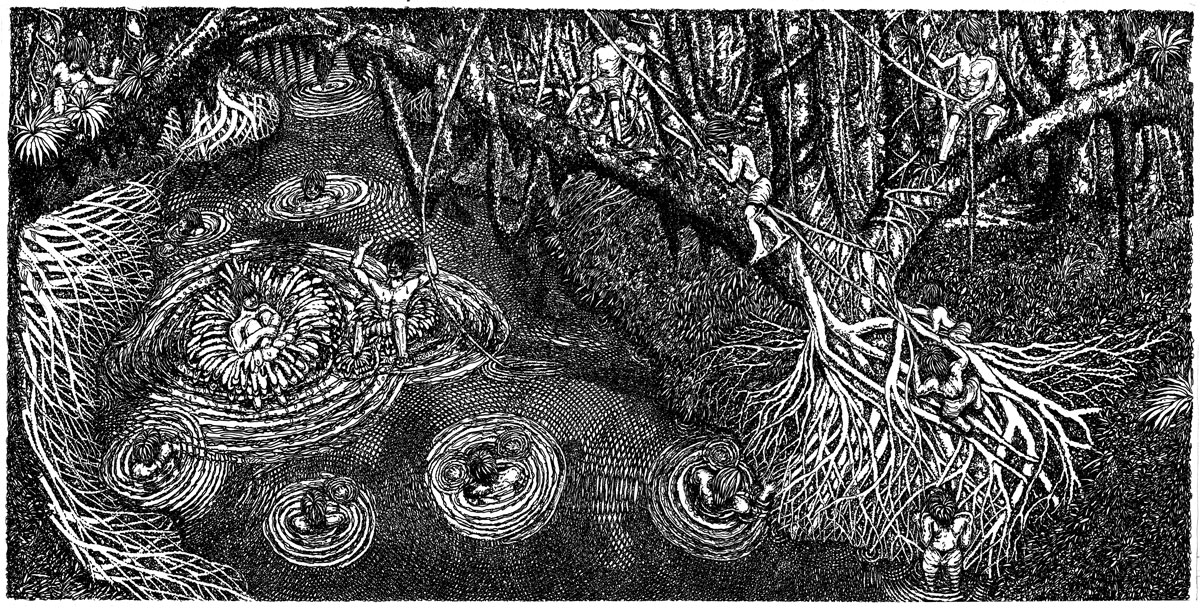
Deru Anding, MOLI’ MILA’ – A journey home to give birth, 120cm x 76cm © Deru Anding
Content from the [Human Nature](http://humannatureshow.com/) art platform Born and raised amongst the Bidayuh Tribe near the jungle in northwest Borneo, Deru Anding’s drawings conjure scenes of a lifestyle and community lost. His panoramic works stretch over a meter in length and are drawn entirely from memory. With his first public exposure here, Human Nature is excited to welcome Deru on board. Over the past decade, 75% of Deru’s homeland has been destroyed for palm oil plantations, logging, and other developments. In the rich jungle imagery he encapsulates and preserves his natural environment and community for present and future generations. His works raise awareness of, and protest against on going tropical deforestation, aiming to encourage wider conservation projects. Deru moved to London in 1998 where he has since lived and worked as an Artist and Architect.

SUPPORTED BY HEROES LIKE YOU
Support independent eco journalism that drives real change.Deru Anding, TUMU’ LALANK, TOKI’ DIA – ‘Grass shoot, tortoise’s poo’, We were told by our forefather to recite this magical chant, to avoid our bare feet to stand on the sharp grass shoots as we run across an open meadow in the jungle, 113cm x 75cm © Deru Anding
Your works are drawn from memories of your upbringing in the jungle in Borneo, before much of it was lost to palm oil plantations, logging and other developments. Can you recall your earliest experience of this?As far as I can remember the developments started in the early 1990s, but the most significant mass deforestation that I witnessed in my area began in 1998.

Deru Anding, SIDUO’ DE’ BAOP – Feeding beneath the canopy, 125cm x 64cm © Deru Anding
Was there a specific moment or event that confirmed your decision to share your work with the public, and what effect do you hope for it to have?There was no specific moment or event, it started gradually as I was reflecting on my earlier life, and sharing memories with my children. I believe it is a lot easier to visualise through my drawings how life was back in the jungle, and I hope that the public take a moment to look and understand the underlying stories.

Deru Anding, NGIBOUH – Using wind to separate paddy and its empty skins, 120cm x 76cm © Deru Anding
You grew up with a community that was closely integrated within the natural world. When you moved to London in 1998, aged 21, what about city life was the hardest thing to adjust to?Before moving to London I had experienced city life in Kuching for few years, so was prepared to adjust and adapt to the new way of life. Back in the jungle almost everything was provided freely by nature. Fishing, hunting, drinking water, fruits, and so on. In London almost nothing is free. It was hard, and still is hard to date, but as far as I am concerned at this point I consider London my new home.

Deru Anding, BITABUM DE’ SADAB – Diving at stream, 124cm x 63cm © Deru Anding
Your beautiful pen works seem so celebrative of their rich natural imagery, but how does the urban landscape of London compare as inspiration for your artwork?London is a beautiful city, multicultural with lots of opportunities. Living in London, sometimes I see myself as a man of many lives. I was brought up for most of my childhood living in the jungle, within the natural world, and then immigrated to the artificial world of London. I feel as if I am a bridge connecting the past and the present. The contrast of the two different worlds is so vast. Often when I look at the tall buildings and skyscrapers in London, they really remind me of tall trees back in the jungle. My imagination often takes me to a point where I wish these tall buildings were actually trees. Looking at the progressive city of London against what is happening back in Borneo, I have no doubt that my home will one day be gone, replaced with the concrete jungle. Experiencing the two different worlds really inspires me to draw my past from the jungle into the present of my adopted home.

Deru Anding, TIKURUOK DE’ BARUK – Dwellers of the sacred house, 123cm x 62cm © Deru Anding
The story of the destruction of forests across Borneo and the loss of your community’s lifestyle is sadly all too familiar. Do you hope with your work to raise the profile of other similar cases of tropical deforestation, and wider related environmental issues?At first I never intended for my drawings to become involved with environmental issues as such. They were created purely from my personal thoughts. However, as I explored the depths of my work, and deforestation as my main subject, it triggered me to use them as a tool to raise awareness of this problem in Borneo and other parts of the world. For more on Deru, visit his artist page on Human Nature



